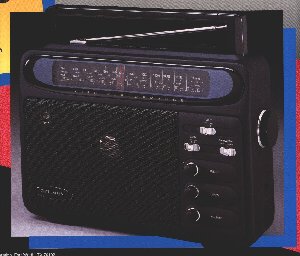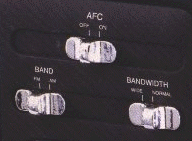The Radio Shack Optimus 12-603 / 12-903 Page


Click on the image above to see an enlarged view ----
I get many inquiries about the Radio Shack Optimus 12-603 and 12-903 radios (now discontinued). People wonder "are they the same as the GE Superradio 3"? I am in a position to answer this question, because I own both. The answer to the question, unfortunatly, is no. The 12-603, and its later re-design, the 12-903 appear to be cost reduced re-designs, based on the GE concept. While there is nothing wrong with cost reduction, and the Radio Shack radios are good radios, they have made some compromises that affect AM DX capability. The 12-603 is actually built better than the GE SR-3, using thicker, more rugged plastic - reminiscant of the GE SR-2, which I also own.
The first clue that I had that the two radios were not identical was obvious even in the store. The arrangement of the secondary controls: "AM/FM", "wide/narrow", and "AFC" is different on the SR-3 and the 12-603:
 |
 |
After doing hardware hacking since I was in seventh grade, I knew that the underlying switches would most likely be soldered onto the PC board, rather than connected with wires. This strongly implied that the circuit board layout is different between the two units. This proved to be the case (see below).
One thing that initially caused me to think I had purchased a defective unit: unlike the GE SR-3, the 12-603 includes an "AC/DC" switch on the back. Initially set to the AC position, the switch prevented me from using the radio with batteries (to minimize AC line noise that would enter the unit if I used the AC cord). When switched to the DC position, the radio worked with batteries. This may cause confusion to the user. One other note related to this switch - it has one of those little dust shields that goes around the shaft inside the radio. I had re-assembled the unit only to find the dust shield sitting on the bench. I then had to take it apart so I could re-install it. Speaking of ---- I have written disassembly instructions for the 12-603.
A visual inspection revealed that the 12-603 circuit board is completely different from the SR3:
Optimus 12-603 circuit board |
GE SR-3 circuit board |
12-603 Board Rear View |
|
Click on the 12-603 front image to get a much larger version, that may be good enough for component identification.
PC Board observations:
This picture also shows the location of the FM ceramic filter, to the bottom left of the IC. The LA1260 is an interesting chip - it has no audio amplifier in it, but it does incorporate an on chip FM discriminator, requiring only an external inductor. The block diagram of the IC is below:
The 12-603 schematic is available here. This is re-drawn from a traced schematic by Superadio III Yahoo group member Peter - many thanks to him for taking the time to trace it out!
The 12-603, like the SR-3, comes poorly aligned, and alignment can improve its performance. I learned many years ago to do "coils low, caps high", and that the tuning dial low and high could be set with the oscillator coil and cap. I don't generally touch FM air coils in wax - too touchy and cranky. I found that the RF cap was slightly off, but the antenna cap was very far off, about 30 degrees brought a dramatic improvement. The AM IF's were slightly off. When touched up, performance improved slightly. Not enough to come anywhere near to the SR-3, but enough to increase the volume on weaker stations. FM alignment did not yield much improvement, but some. It was closer initially to being correct. I found myself wondering why there was no FM antenna cap, and what sort of improvement it would yield if present. After all, the AM antenna cap yielded the most AM improvement.
The picture below shows the alignment points for the 12-603.
Since I don't have the manual, here is the procedure I use to do a quick alignment of the unit.

Feel free to grab the graphic and re-scale it on your printer to match the original. It must be the exact same size, or you can't do oscillator adjustments!
Don't attempt FM alignment unless you have instruments and know what you are doing. If you absolutely must try, a similar procedure can be used - but it is really easy to mess up (especially the FM IF and Detector). Mark the positions in case you want to go back! Spreading and compressing FM coils is a pain in the postierior. There are plastic tools made for this task - it would be a good idea to buy one! The coils low caps high method works fairly well, the problem is that even very weak stations may come in with full quieting - this is FM we are talking about, not amplitude modulation.
The 12-603 mods have been moved to their own page here. They now include the excellent work done by Superadio III Yahoo group member Peter, who generously allowed me to post them.